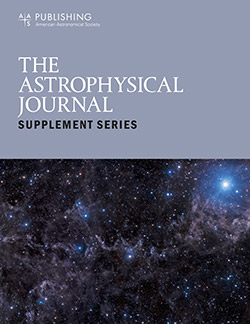Classification of Chandra X-Ray Sources in Cygnus OB2
IF 8.6
1区 物理与天体物理
Q1 ASTRONOMY & ASTROPHYSICS
引用次数: 6
Abstract
Abstract We have devised a predominantly Naive Bayes−based method to classify X-ray sources detected by Chandra in the Cygnus OB2 association into members, foreground objects, and background objects. We employ a variety of X-ray, optical, and infrared characteristics to construct likelihoods using training sets defined by well-measured sources. Combinations of optical photometry from the Sloan Digital Sky Survey ( riz ) and Isaac Newton Telescope Photometric H α Survey ( r I i I H α ), infrared magnitudes from United Kingdom Infrared Telescope Deep Sky Survey and Two-Micron All Sky Survey ( JHK ), X-ray quantiles and hardness ratios, and estimates of extinction A v are used to compute the relative probabilities that a given source belongs to one of the classes. Principal component analysis is used to isolate the best axes for separating the classes for the photometric data, and Gaussian component separation is used for X-ray hardness and extinction. Errors in the measurements are accounted for by modeling as Gaussians and integrating over likelihoods approximated as quartic polynomials. We evaluate the accuracy of the classification by inspection and reclassify a number of sources based on infrared magnitudes, the presence of disks, and spectral hardness induced by flaring. We also consider systematic errors due to extinction. Of the 7924 X-ray detections, 5501 have a total of 5597 optical/infrared matches, including 78 with multiple counterparts. We find that ≈6100 objects are likely association members, ≈1400 are background objects, and ≈500 are foreground objects, with an accuracy of 96%, 93%, and 80%, respectively, with an overall classification accuracy of approximately 95%.天鹅座OB2中钱德拉x射线源的分类
我们设计了一种主要基于朴素贝叶斯的方法,将钱德拉望远镜探测到的天鹅座OB2 x射线源分为成员、前景物体和背景物体。我们使用各种x射线、光学和红外特征来使用由良好测量源定义的训练集构建可能性。结合斯隆数字巡天(riz)和艾萨克牛顿望远镜光度测量H α (r I I I H α)的光学光度测量、英国红外望远镜深空巡天和2微米全天空巡天(JHK)的红外星等、x射线分位数和硬度比以及消光A v的估计,计算出给定光源属于某一类的相对概率。主成分分析用于分离光度数据类别的最佳轴,高斯分量分离用于x射线硬度和消光。测量误差由高斯模型和近似为四次多项式的似然积分来解释。我们通过检查来评估分类的准确性,并根据红外星等、盘的存在和由耀斑引起的光谱硬度对一些源进行重新分类。我们还考虑由于消光引起的系统误差。在7924个x射线探测中,5501个总共有5597个光学/红外匹配,其中78个有多个对应。我们发现,约6100个对象可能是关联成员,约1400个是背景对象,约500个是前景对象,准确率分别为96%、93%和80%,总体分类准确率约为95%。
本文章由计算机程序翻译,如有差异,请以英文原文为准。
求助全文
约1分钟内获得全文
求助全文
来源期刊

Astrophysical Journal Supplement Series
地学天文-天文与天体物理
CiteScore
14.50
自引率
5.70%
发文量
264
审稿时长
2 months
期刊介绍:
The Astrophysical Journal Supplement (ApJS) serves as an open-access journal that publishes significant articles featuring extensive data or calculations in the field of astrophysics. It also facilitates Special Issues, presenting thematically related papers simultaneously in a single volume.
 求助内容:
求助内容: 应助结果提醒方式:
应助结果提醒方式:


